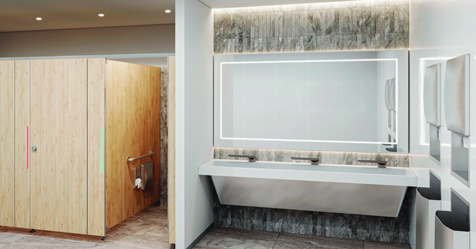The Kohl Children’s Museum in Glenview, IL, welcomes more than 300,000 visitors to its facility each year. During its peak season, the museum may see as many as 34,000 visitors on a given month. No matter how you slice it or dice it, that’s a lot of people accessing the museum’s amenities each day—a lot of hands touching the interactive exhibits, a lot of feet scuffing up the carpets, and a lot of bodies (both kids and adults) scuffling in and out of the facility restrooms.
In a facility as busy as the Kohl Children’s Museum, one can imagine how challenging it must be to keep the busiest areas as clean as possible—let alone an area as germ-prone as a restroom. But the museum seems to have it down to a science. In order to keep the museum’s restrooms in tiptop shape—particularly during the busy season—custodial staff spot check the restrooms up to twice per hour.
During this time, areas like the sinks and faucets will receive a quick spray, while the baby changing table receives a wipe down with a light sanitizing solution. The museum also has a cot in the family restroom that is available for nursing mothers or changing larger children; that area is disinfected daily.
Regardless of how seamless a facility’s process may be for cleaning its restrooms, these spaces are regularly ranked as a top problem area by in-house facility managers and BSCs who read CMM. It’s not too difficult to pinpoint why. From odors to bodily fluids and plumbing issues, these spaces often give custodial teams a run for their money.
As unpleasant as the following pointers may be to read, here are five restroom areas that are often overlooked but prone to presenting problems for any custodian.
Baby Changing Stations
As the coordinator of custodial services for an entire school district with more than 60 buildings and 5 million square feet, Marcus LaPointe has seen his fair share of baby changing stations—or diaper changing tables, as some call them. These surfaces “are a nightmare in any organization,” LaPointe says, particularly when it comes to training on how to clean and disinfect them.
It’s important to remember baby changing stations fall victim to more than just a baby’s bottom whenever they are in use. While babies are cute, they may also be covered in snot, food, messes from leaking diapers, and other germs they’ve acquired from crawling on the floor or playing with other kids. In a sense, they are human-size petri dishes.
For that reason, LaPointe says, it’s important to clean and disinfect the entire baby changing station, and not just particular areas. The proper way to do this is by:
- Cleaning it with a neutral cleaner
- Spraying it with a disinfectant
- Letting it air dry.
LaPointe’s custodians go through this procedure once per day, so he knows for certain the stations in his buildings have all received attention. But not all restrooms are created equal. “I think with cleaning crews having so little time to do their job… when they walk into the bathroom, they move so fast that they don’t open it and actually [clean the table,]” he says. It’s possible they are just cleaning the outside.
Floor Drains
Before his days in the custodial field, LaPointe spent 15 years working as a plumber. From this, he knows how important it can be to make sure the restroom drains—which are susceptible to obstruction from floor wax—are open. “You have to make sure those holes are open, so if there is ever an issue in the bathroom, the water goes down that floor drain instead of [trailing out into the hallway or carpet],” he says. If you don’t, you could end up having to disinfect the carpet and other areas of the building, as well.
In the end, making sure the floor drain is in working order can save hours of cleaning in the case of an accidental flood or leak. Removing the floor drain every now and then to clean it with a wire brush can help to prevent a small accident from becoming a large one.
Feminine Hygiene Receptacles
Feminine hygiene receptacles—waste bins dedicated to products like tampons and sanitary napkins—are tricky because despite their contents, the U.S. Department of Labor’s Occupational Safety and Health Administration (OSHA) doesn’t consider them to contain regulated waste. This puts the onus of handling waste with bodily fluids on bathroom attendants who may or may not be properly trained to attend to them.
Additionally, even in today’s world, “it still is a taboo to talk about menstruation,” according to Ann Germanow, Founder and CEO of Scensible Source Co., LLC. This makes it even more challenging to enforce proper protocol and quality control when it comes to cleaning the women’s restrooms. “Even when the supervisor may go in a do an inspection, he may look at the outside of the receptacle,” Germanow says, “but do you think he’s ever going to lift up the lid?” Based on what she has seen in her frequent inspections of restrooms, it’s unlikely.
While OSHA does require receptacles to have proper lining to prevent employees from having to touch the trash contents, the onus really falls on the facility to provide safe disposal methods, such as single-use disposal bags and right-sized liners that conceal odors and waste.
In addition to changing the liners, custodians should regularly clean both the inside and the outside of the feminine waste receptacles. To do this, bathroom attendants should first preclean the receptacle with an all-purpose cleaner to remove any soil and then disinfect it after.
Graffiti
It’s not uncommon for custodial staff to walk into a restroom stall, clean the toilet, wipe the stall down, and then move on to the next one without completely going inside and closing the door behind them, according to Darrel Hicks, CEO of Darrel Hicks, LLC and EVS director at GCI Certified. Even if your custodial staff are changing the trash and checking the dispensers, cleaning a restroom stall to the fullest may require a few extra steps.
If you’re pushing your custodial staff to take their restroom cleaning to the next level, consider asking them to look at each restroom stall from the customer or user perspective while they are in there cleaning. They may notice scribbles—or graffiti—up and down the partitions.
“Graffiti on walls promotes more graffiti,” Hicks says. “If you don’t remove it daily, then it can get out of hand pretty quickly.”
Ensuring your staff has a solvent-based graffiti remover in stock and on the cleaning cart at all times can help make this process a regular part of the restroom cleaning routines. Cleaning pads may be too aggressive, as they could end up removing stall paint.
Stall Latches
Unless you are looking at a single-use or family restroom, it’s not likely restroom patrons will find a faucet and soap next to the toilet. In that case, you may want to ensure your cleaning crews are paying extra attention to the stall latches. This is another area Hicks says custodians tend to overlook. Similar to other doorknobs and handles, this high-touch area is prone to germs, especially because restroom patrons use it to exit the stall once they are done using the toilet. Since latches tend to be stainless steel, Hicks recommends cleaning them with a disinfectant suitable for nonporous surfaces.
Combat with a Checklist
These five trouble areas provide just a snapshot of the challenges our industry faces when it comes to restroom cleaning and maintenance. From plumbing issues to maintaining grout, it would be easy to go on about issues that constantly plague our facility restrooms. While cost and lack of time may contribute to why certain areas of the restroom may not receive as much attention as others, a simple sign-in sheet or a detailed cleaning checklist near a trouble area may help to combat areas of the restroom that are prone to neglect.




